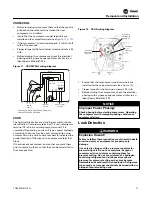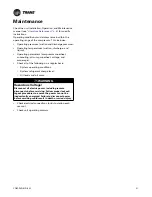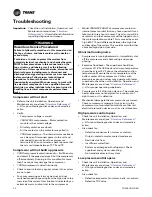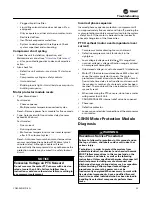
General Information
12
COM-SVN01D-EN
Reuse the compressors mounting isolators or mounting
spacers that are used with the existing compressor
assembly.
Braze the compressor into the system. Compressor
connections are copper-plated steel. Use BAg-28, 40%
silver, with paste flux to make the copper tube connections
to the compressor.
Proceed with the following as described in the following
sections:
•
•
“Vacuum Testing and Evacuation,” p. 18
•
“Verification Before Start-Up,” p. 19
Electrical Failure
Replace only the failed compressor in a tandem or trio set.
Drain and replace the oil in all the non-failed compressors.
Reuse the compressors mounting isolators or mounting
spacers that are used with the existing compressor
assembly.
Braze compressor into the system. Compressor
connections are copper-plated steel. Use BAg-28, 40%
silver, with paste flux to make the copper tube connections
to the compressor.
Important:
On tandem or trio assemblies, the suction
and discharge lines must not be modified,
except for the use of slip joint couplings.
Other modification may cause oil return
issues and lead to compressor failure. Cut
the lines in a convenient place, remove the
compressor then unbraze the lines from the
compressor. On reinstallation, reinstall
lines to compressor and reassemble the cut
lines with a slip coupling. See
for suggested area to cut the discharge and
suction line.
Minimize system and compressor open times to avoid
excessive moisture absorption by the POE oil. Maximum
suggested open time is 15 minutes.
Test the acid condition of the oil in the compressors using
an acid test kit. Use Trane Part Numbers KIT06815,
CHM00414, and KIT06754.
Two Types of Motor Failures
Light.
If oil test kit is negative and oil is only slightly
discolored, treat in the same manner as a mechanical
failure.
Severe.
If oil test kit is positive with strong pungent odor
and dark oil, drain and replace oil in all of the non-failed
compressors.
Reuse the compressor mounting isolators or mounting
spacers that are used with the existing compressor
assembly.
This type of failure requires changing both the suction and
liquid line filter-driers. Use replaceable filter-drier cores to
facilitate changing filter-driers, if required.
Install the suction filters no closer than the distance listed
in the following table. The distance is measured from the
centerline of the suction inlet tee (see
).
Braze compressor into the system. Compressor
connections are copper-plated steel. Use BAg-28, 40%
silver, with paste flux to make the copper tube connections
to the compressor.
Proceed with the following as described in previous
sections:
•
•
“Vacuum Testing and Evacuation,” p. 18
•
•
“Verification Before Start-Up,” p. 19
Figure 8.
Minimum distance before installation of
suction line filter
X Minimum Distance
Compressor Model “X” Distance
CSHD
10 inches
CSHN tandem
16 inches
CSHN trio
25 inches
1. Use acid removal type filter-drier cores in both the
suction filter and liquid line filter drier.
2. Change when the pressure drop exceeds 4 psig.
CSHN/CSHL models
Test oil after 24 hours of operation. Change filter-drier
again if required. If oil is still acid, drain and replace oil in
all the non-failed compressors.
After system is clean, test kit indicates okay, remove the
suction clean up filter-drier and replace the liquid line drier
with standard filter drier cores.
CSHD models
Since CSHD compressors do not have an oil drain valve
that allows complete oil charge removal, it is
recommended that after 24 hours of operation, the filter-
drier cores be replaced with acid removal filter-drier cores.
Operate the system for another 24 hours before changing
to remove the suction filter-drier and install a standard
filter-drier in the liquid line.













































